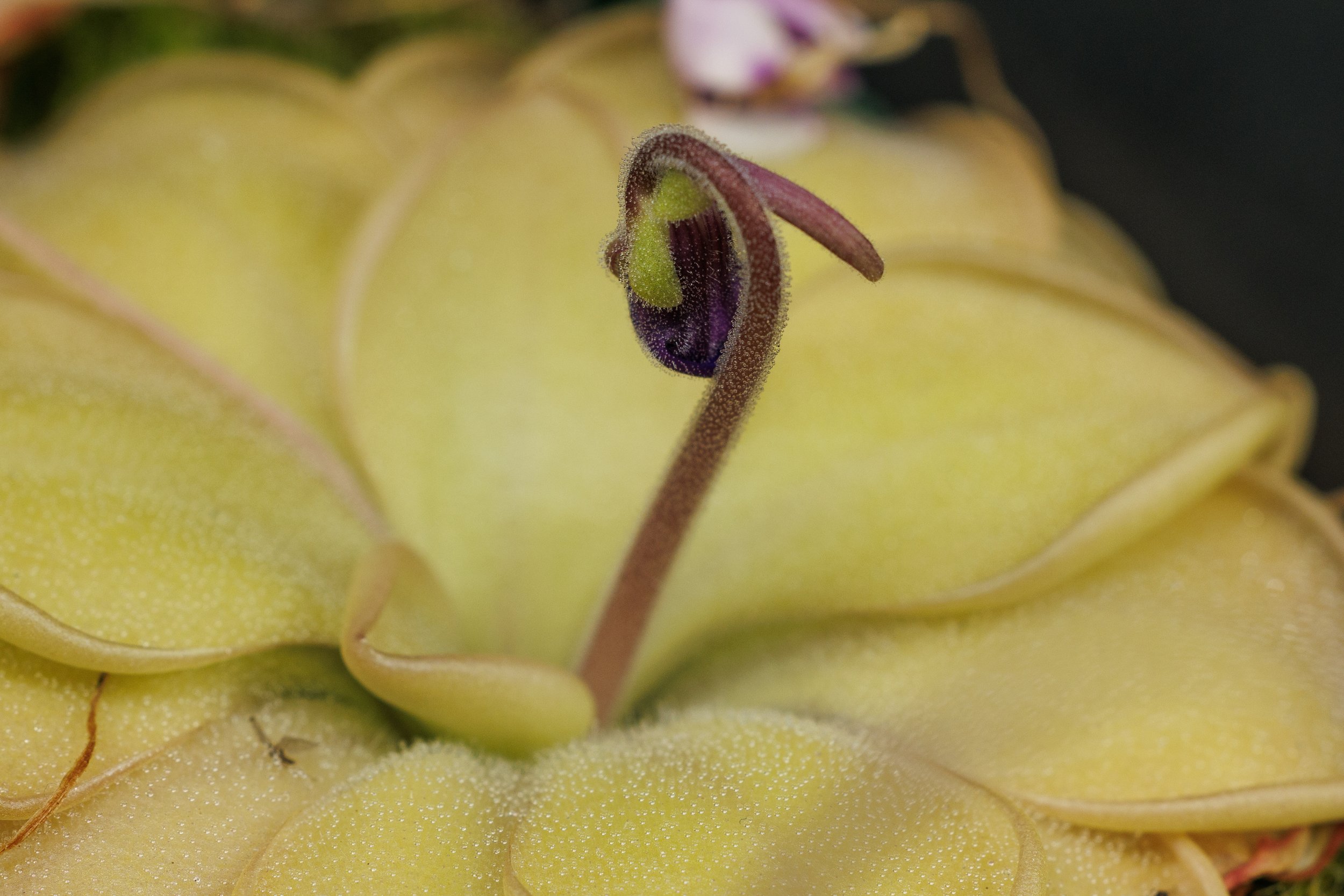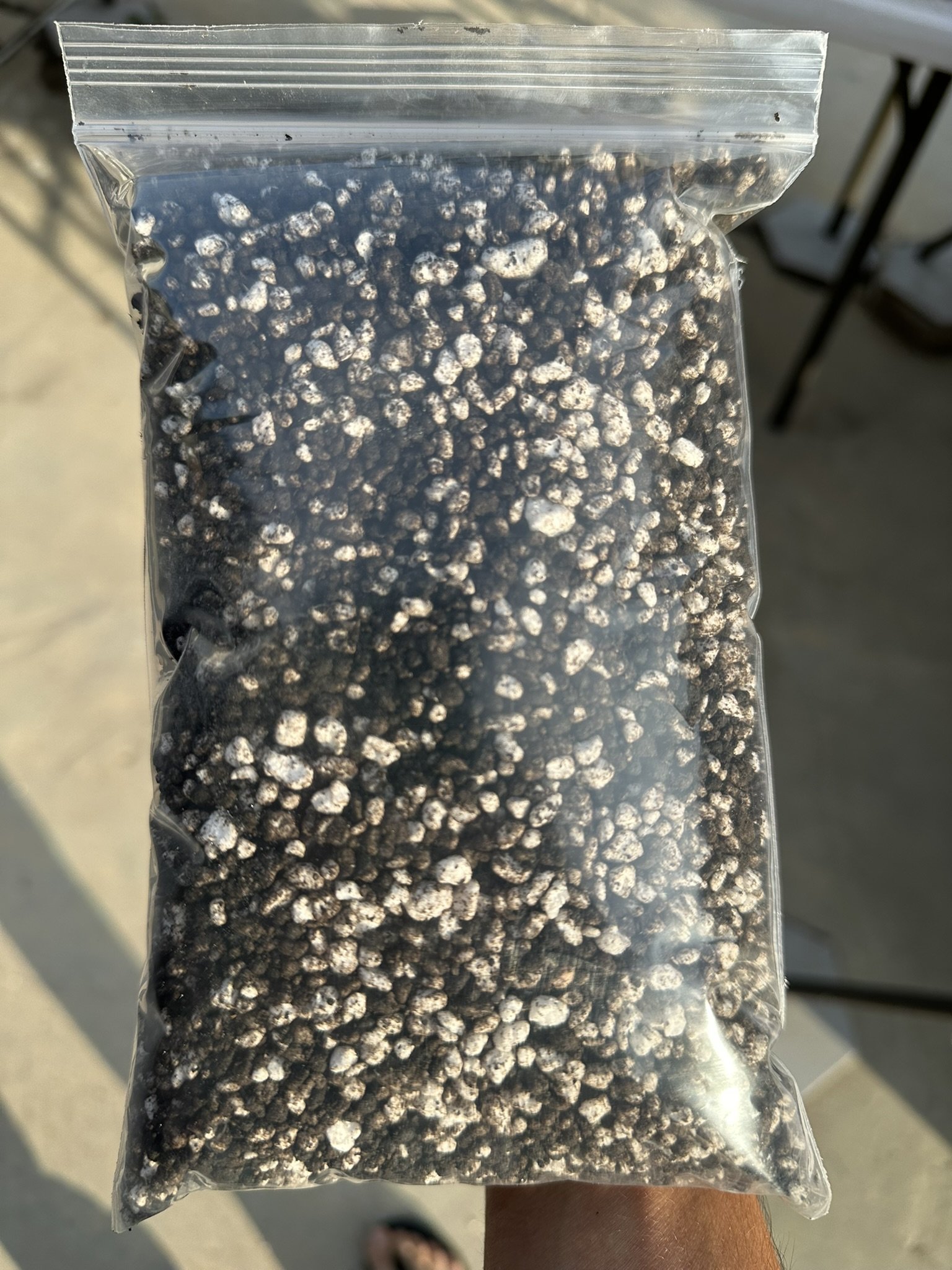 Image 1 of 7
Image 1 of 7

 Image 2 of 7
Image 2 of 7

 Image 3 of 7
Image 3 of 7

 Image 4 of 7
Image 4 of 7

 Image 5 of 7
Image 5 of 7

 Image 6 of 7
Image 6 of 7

 Image 7 of 7
Image 7 of 7








Pinguicula x 'Titan'
NOTE: Tropical Pinguicula ship bareroot and need to be planted upon arrival. Tropical Pinguicula soil mix is available in the shop.
NOTE: During winter and early spring, Tropical Butterworts may be in their winter succulent phase with smaller, thicker leaves. They will grow new large carnivorous leaves in the spring.
Description
Pinguicula x ‘Titan’ is a huge Tropical Butterwort hybrid with wide, green-bronze leaves that can exceed 6” in diameter. The flowers are also large with a pink-lavender color with a darker center. This hybrid was created by Leo Song and is thought to be the cross Pinguicula agnata x macrophylla. The winter succulent phase has large green succulent leaves.
Tropical Butterworts (Pinguicula) are exceptionally voracious gnat catchers. Their colorful, flat leaves are covered in tiny sticky hairs which attract and trap small flies and gnats for digestion. What makes this group of Butterworts so fascinating is their beautiful neon pink, purple, and white flowers. Many of these species have a cute winter succulent phase where the leaves shrink down into a nice geometric pattern. The colorful rosettes and orchid-like flowers make these amazing carnivorous plants for any collection.
Tropical Butterworts live in the cool, foggy mountains of Central America, typically on rocky slopes but sometimes epiphytically in moss on tree trunks. Most of these species have a unique winter succulent form — during the cool, dry winters they will shrink into a dense, geometric cluster of non-carnivorous succulent leaves. They can remain in this form with little growth for months, eventually bursting out of dormancy with larger, carnivorous leaves throughout the warmer wet season. There are roughly 60 species of these Tropical Butterworts that can vary in size from 1” to over 10” in diameter and each has different shapes and colors.
Small plants are roughly 0.75-1” in diameter. Medium plants are roughly 1-2” in diameter. Large plants will be over 2” in diameter and fully mature, flowering size. Sizing is based on their carnivorous stage and plants may appear smaller during dormancy. They need to be gently potted into an appropriate soil mix upon arrival.
Pinguicula x ‘Titan’ is currently dormant in early spring and will ship as a dense bud that should be plant with the top roughly level with the soil surface (buried up to the top, but not covered).
Growing Information
Climate: Temperatures from 50-85F - they prefer some humidity but can adapt to lower humidity.
Light: Part Sun or 15W per sq ft LED light. These do well under LED lights and will attain great color.
Water: Distilled or Reverse Osmosis water. Sitting in ~0.5” of water using tray method. They can also be top watered regularly in humid environments, but the tray method is simpler.
Soil: Using standard garden store materials, a mix of roughly 20% Peat Moss: 60% Perlite: 20% Sand will work. I like using a mix of Perlite/Volcanic Clay Granules/Calcined Clay Chips but lots of granular, well draining mixes will work. Rinse media with distilled or reverse osmosis water to remove excess salts. Because the roots are shallow, they do not require deep pots but pot height will influence moisture wicking to the surface.
Feeding: Foliar feeding is easiest at a frequency of once or twice per month with 1/4 tsp per gallon MaxSea or roughly 200ppm Dynagro Gro/Foliage Pro or Schultz Cactus Fertilizer.
NOTE: Tropical Pinguicula ship bareroot and need to be planted upon arrival. Tropical Pinguicula soil mix is available in the shop.
NOTE: During winter and early spring, Tropical Butterworts may be in their winter succulent phase with smaller, thicker leaves. They will grow new large carnivorous leaves in the spring.
Description
Pinguicula x ‘Titan’ is a huge Tropical Butterwort hybrid with wide, green-bronze leaves that can exceed 6” in diameter. The flowers are also large with a pink-lavender color with a darker center. This hybrid was created by Leo Song and is thought to be the cross Pinguicula agnata x macrophylla. The winter succulent phase has large green succulent leaves.
Tropical Butterworts (Pinguicula) are exceptionally voracious gnat catchers. Their colorful, flat leaves are covered in tiny sticky hairs which attract and trap small flies and gnats for digestion. What makes this group of Butterworts so fascinating is their beautiful neon pink, purple, and white flowers. Many of these species have a cute winter succulent phase where the leaves shrink down into a nice geometric pattern. The colorful rosettes and orchid-like flowers make these amazing carnivorous plants for any collection.
Tropical Butterworts live in the cool, foggy mountains of Central America, typically on rocky slopes but sometimes epiphytically in moss on tree trunks. Most of these species have a unique winter succulent form — during the cool, dry winters they will shrink into a dense, geometric cluster of non-carnivorous succulent leaves. They can remain in this form with little growth for months, eventually bursting out of dormancy with larger, carnivorous leaves throughout the warmer wet season. There are roughly 60 species of these Tropical Butterworts that can vary in size from 1” to over 10” in diameter and each has different shapes and colors.
Small plants are roughly 0.75-1” in diameter. Medium plants are roughly 1-2” in diameter. Large plants will be over 2” in diameter and fully mature, flowering size. Sizing is based on their carnivorous stage and plants may appear smaller during dormancy. They need to be gently potted into an appropriate soil mix upon arrival.
Pinguicula x ‘Titan’ is currently dormant in early spring and will ship as a dense bud that should be plant with the top roughly level with the soil surface (buried up to the top, but not covered).
Growing Information
Climate: Temperatures from 50-85F - they prefer some humidity but can adapt to lower humidity.
Light: Part Sun or 15W per sq ft LED light. These do well under LED lights and will attain great color.
Water: Distilled or Reverse Osmosis water. Sitting in ~0.5” of water using tray method. They can also be top watered regularly in humid environments, but the tray method is simpler.
Soil: Using standard garden store materials, a mix of roughly 20% Peat Moss: 60% Perlite: 20% Sand will work. I like using a mix of Perlite/Volcanic Clay Granules/Calcined Clay Chips but lots of granular, well draining mixes will work. Rinse media with distilled or reverse osmosis water to remove excess salts. Because the roots are shallow, they do not require deep pots but pot height will influence moisture wicking to the surface.
Feeding: Foliar feeding is easiest at a frequency of once or twice per month with 1/4 tsp per gallon MaxSea or roughly 200ppm Dynagro Gro/Foliage Pro or Schultz Cactus Fertilizer.
NOTE: Tropical Pinguicula ship bareroot and need to be planted upon arrival. Tropical Pinguicula soil mix is available in the shop.
NOTE: During winter and early spring, Tropical Butterworts may be in their winter succulent phase with smaller, thicker leaves. They will grow new large carnivorous leaves in the spring.
Description
Pinguicula x ‘Titan’ is a huge Tropical Butterwort hybrid with wide, green-bronze leaves that can exceed 6” in diameter. The flowers are also large with a pink-lavender color with a darker center. This hybrid was created by Leo Song and is thought to be the cross Pinguicula agnata x macrophylla. The winter succulent phase has large green succulent leaves.
Tropical Butterworts (Pinguicula) are exceptionally voracious gnat catchers. Their colorful, flat leaves are covered in tiny sticky hairs which attract and trap small flies and gnats for digestion. What makes this group of Butterworts so fascinating is their beautiful neon pink, purple, and white flowers. Many of these species have a cute winter succulent phase where the leaves shrink down into a nice geometric pattern. The colorful rosettes and orchid-like flowers make these amazing carnivorous plants for any collection.
Tropical Butterworts live in the cool, foggy mountains of Central America, typically on rocky slopes but sometimes epiphytically in moss on tree trunks. Most of these species have a unique winter succulent form — during the cool, dry winters they will shrink into a dense, geometric cluster of non-carnivorous succulent leaves. They can remain in this form with little growth for months, eventually bursting out of dormancy with larger, carnivorous leaves throughout the warmer wet season. There are roughly 60 species of these Tropical Butterworts that can vary in size from 1” to over 10” in diameter and each has different shapes and colors.
Small plants are roughly 0.75-1” in diameter. Medium plants are roughly 1-2” in diameter. Large plants will be over 2” in diameter and fully mature, flowering size. Sizing is based on their carnivorous stage and plants may appear smaller during dormancy. They need to be gently potted into an appropriate soil mix upon arrival.
Pinguicula x ‘Titan’ is currently dormant in early spring and will ship as a dense bud that should be plant with the top roughly level with the soil surface (buried up to the top, but not covered).
Growing Information
Climate: Temperatures from 50-85F - they prefer some humidity but can adapt to lower humidity.
Light: Part Sun or 15W per sq ft LED light. These do well under LED lights and will attain great color.
Water: Distilled or Reverse Osmosis water. Sitting in ~0.5” of water using tray method. They can also be top watered regularly in humid environments, but the tray method is simpler.
Soil: Using standard garden store materials, a mix of roughly 20% Peat Moss: 60% Perlite: 20% Sand will work. I like using a mix of Perlite/Volcanic Clay Granules/Calcined Clay Chips but lots of granular, well draining mixes will work. Rinse media with distilled or reverse osmosis water to remove excess salts. Because the roots are shallow, they do not require deep pots but pot height will influence moisture wicking to the surface.
Feeding: Foliar feeding is easiest at a frequency of once or twice per month with 1/4 tsp per gallon MaxSea or roughly 200ppm Dynagro Gro/Foliage Pro or Schultz Cactus Fertilizer.

